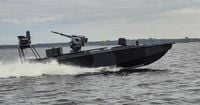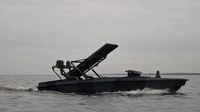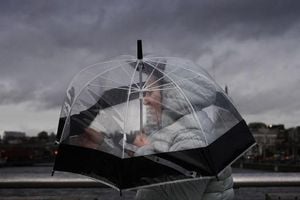Ukraine’s battle for control of the Black Sea has entered a new phase, as the country’s security service unveiled an upgraded version of its now-famous “Sea Baby” naval drone. The announcement, made public on October 22, 2025, marks a significant leap in Kyiv’s campaign to challenge Russian dominance at sea using cutting-edge, homegrown technology. With an expanded range, heavier payload, and artificial intelligence-assisted targeting, the new Sea Baby is designed to operate anywhere in the Black Sea—and it’s already changing the rules of naval warfare.
The Security Service of Ukraine (SBU) presented the latest Sea Baby variants at a demonstration for journalists, though the precise time and location were kept under wraps for security reasons, according to Associated Press. The Sea Baby’s range has been extended from 1,000 kilometers (about 620 miles) to a formidable 1,500 kilometers (930 miles), allowing it to reach any point in the Black Sea and even beyond. The drone can now carry up to 2,000 kilograms (roughly 4,400 pounds) of payload, doubling its previous capacity and enabling a wider array of missions.
What’s under the hood? The new Sea Baby comes in several variants, including models fitted with multiple rocket launchers and others equipped with gyro-stabilized, automated machine gun turrets. These enhancements aren’t just for show: they allow the drones to strike both sea and land targets, defend themselves against enemy drones, and even launch smaller aerial attack drones. The SBU says the new generation is also equipped with reinforced engines and a modern navigation system, making it more reliable in the face of electronic warfare and rough sea conditions.
Perhaps the most futuristic upgrade is the incorporation of artificial intelligence. The Sea Baby’s AI-assisted friend-or-foe targeting system helps operators distinguish between Russian and Ukrainian vessels, reducing the risk of friendly-fire incidents. The drones are controlled remotely from a mobile command center inside a van, where operators sit before a bank of screens and controls. “Cohesion of the crew members is probably the most important thing. We are constantly working on that,” said one operator, identified only by his call sign, “Scout,” as reported by AP.
Ukraine has invested heavily in these naval drones, partially funding the program through the government-run United24 crowdfunding initiative. According to Reuters, President Volodymyr Zelenskiy recently stated that Ukraine produces around 4,000 naval drones, but only needs half for its own defense. “Why not sell those 2,000 to partners? That’s normal. Let companies sell,” Zelenskiy told journalists, hinting at Kyiv’s ambitions to become a global supplier of naval drone technology.
The Sea Baby’s battlefield record is already impressive. Since the full-scale war began in early 2022, various iterations of the drone have struck at least 11 Russian ships, including frigates and missile carriers. These attacks have forced the Russian navy to relocate its main Black Sea base from Sevastopol in Crimea to Novorossiysk on Russia’s Black Sea coast—a strategic win for Ukraine. The drones have also been credited with repeated attacks on the Crimean Bridge, most recently targeting its underwater supports in an effort to disrupt Russian military logistics. As SBU chief Lt. Gen. Vasyl Malyuk put it, “Our drones have changed the balance of power in the Black Sea and proven their effectiveness. The new generation of ‘Sea Baby’ is even more efficient.”
But the innovations don’t stop there. Some Sea Baby drones have been modified to carry surface-to-air missile launchers, giving them the ability to shoot down Russian aircraft. Others serve as launch platforms for smaller quadcopter drones, expanding their operational flexibility. To prevent these valuable assets from falling into enemy hands, the Sea Baby includes multilayered self-destruct systems. “Kyiv tries to prevent Russia from capturing technology in Ukrainian ‘sea baby’ drones by introducing a self-destruct mechanism in case of the threat of enemy capture,” Brig. Gen. Ivan Lukashevych told Reuters.
Ukraine’s reliance on naval drones has been born out of necessity. With a traditional navy all but neutralized, Kyiv has turned to unmanned systems and missiles to wage an asymmetric campaign against Russian forces in the Black Sea. According to Business Insider, these efforts have damaged or destroyed dozens of Russian warships over the past three years and helped keep key civilian trade routes open to Europe. As Lukashevych explained, “We need our commercial fleet to sail, to work, to keep the economy breathing, so that the Russians cannot influence it.”
The success of the Sea Baby has not gone unnoticed. NATO forces are closely monitoring developments in the Black Sea, adjusting their own training and tactics in anticipation of similar threats in future conflicts. “The SBU is the ideologist of a new type of naval warfare,” Lukashevych said. “We are constantly looking for effective means to maintain Ukraine’s advantage in the Black Sea for as long as possible.”
Of course, this technological arms race cuts both ways. “We know that Russia is trying to copy Ukrainian naval drones and, to the extent possible, is already using them against Ukrainian territory,” Lukashevych noted. Both sides have developed sophisticated electronic jamming devices to scramble enemy drones, prompting a cycle of innovation as each tries to outmaneuver the other. Military analyst Serhii Kuzan told Reuters that the growing role of naval drones means port defenses must be strengthened, including the use of buoy barriers and expanded electronic warfare capabilities.
The Sea Baby program’s transformation from expendable strike craft to reusable, networked platform marks a watershed moment in modern naval warfare. As Lukashevych explained at the demonstration, “On this new product, we have installed rocket weaponry that will allow us to work from a large distance outside of the attack range of enemy fire. We can use such platforms to carry heavy weaponry. Here we can show Ukrainians the most effective use of the money they have donated to us.”
Meanwhile, the broader context of the conflict remains grim. As Ukraine unveiled its upgraded sea drones, Russia continued launching waves of missiles and drones at Ukrainian cities and towns, including strikes on a kindergarten in the Kyiv region, according to NDTV. Ukraine responded with British-made Storm Shadow missiles, targeting a chemical plant in Russia’s Bryansk region. The Black Sea campaign, however, stands out as a rare bright spot for Kyiv, demonstrating how low-cost, innovative technology can counter expensive, traditional warships.
With the Sea Baby now roaming the Black Sea, the balance of power in the region looks set for further upheaval. Ukraine’s gamble on naval drones has not only reshaped the current conflict but may also redefine how nations wage war at sea for years to come.





